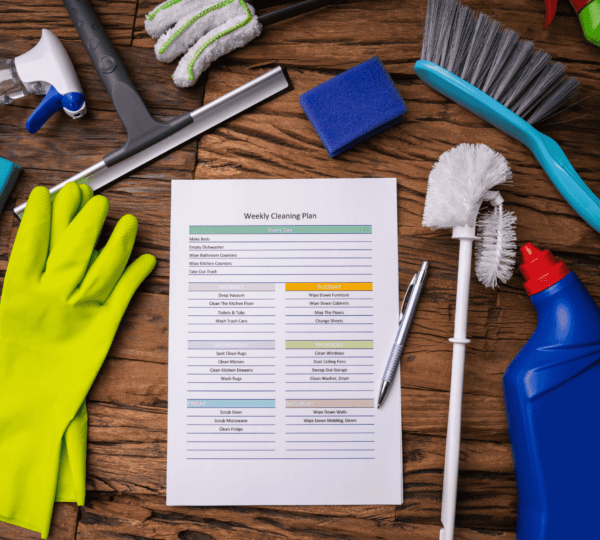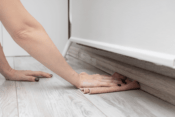
How to Clean Your Home with Kids Around: A Complete Guide
Cleaning with kids around can be a daunting task. It’s like trying to herd cats, with toys scattered everywhere and sticky fingerprints on every surface. But it doesn’t have to be a constant battle.
Did you know that the average American family spends over 10 hours a week cleaning their home? That’s a lot of time! And when you have kids, it can feel even more overwhelming.
However, there are ways to make cleaning with kids a more enjoyable and productive experience. By creating a family cleaning schedule, making cleaning fun for kids, using age-appropriate cleaning tasks, and keeping your kids safe while cleaning, you can turn a chore into a bonding activity.
In this guide, we’ll share practical tips and tricks to help you achieve a cleaner home while fostering a sense of responsibility and teamwork in your family.
Understanding the Challenge
Cleaning with kids around is more than just picking up after them. It’s about managing constant interruptions, balancing multiple tasks, and sometimes, dealing with resistance from the little ones. According to a study by the Pew Research Center, parents of young children report spending an average of 23 hours per week on housework, which can be even more challenging when kids are constantly undoing your efforts.
But don’t worry—there are practical solutions. Before we delve into the specifics, let’s look at why this is such a common struggle for parents.
Expert Insight: Why Cleaning with Kids is Different
Dr. Mary Johnson, a pediatric psychologist with over 20 years of experience, explains why cleaning with kids is so difficult. “Children, especially younger ones, thrive on exploration and discovery,” she says. “What might look like chaos to you is their way of learning about the world. They don’t mean to make cleaning harder, but their developmental stage means they’re more likely to create messes than help with them.”
Dr. Johnson’s expertise in child development gives her a unique understanding of the challenges parents face. Her research focuses on how children’s behavior affects family routines, and her insights have been featured in several parenting journals.
Step-by-Step Guide to Cleaning Your Home with Kids Around
1. Set Realistic Expectations
First things first: acknowledge that your house won’t look perfect all the time, and that’s okay! Trying to keep everything spotless while raising kids can lead to frustration. Instead, focus on maintaining a home that’s functional and clean enough for comfort and health.
As parenting expert Janet Lansbury puts it, “A clean home isn’t about perfection—it’s about creating an environment where you and your family feel comfortable and safe.” Lansbury, known for her work in respectful parenting, emphasizes that reducing the pressure for a spotless home can reduce stress for both parents and kids.
2. Create a Daily Routine
Having a consistent cleaning routine can make a big difference. When your kids know what to expect, they’re less likely to disrupt the flow of things. Set aside specific times during the day for certain tasks. For example:
- Morning: Make beds, tidy bedrooms.
- Afternoon: Quick kitchen clean-up after meals.
- Evening: Pick up toys before bed.
Research from The American Academy of Pediatrics highlights the importance of routines in children’s lives. Routines help children feel secure, and when cleaning is part of the daily schedule, they’ll be more likely to participate.
3. Involve Your Kids in the Process
Yes, it’s possible to get your kids involved in cleaning! Not only does this help lighten your load, but it also teaches them responsibility. Start with age-appropriate tasks:
- Toddlers: Help put toys back into bins.
- Preschoolers: Dust low surfaces or match socks.
- Older children: Vacuum small areas or wipe down surfaces.
Studies from Harvard University show that children who are involved in household chores from a young age tend to develop better organizational skills and a stronger sense of responsibility. While it may take a bit longer at first, involving your kids in cleaning will benefit them (and you) in the long run.
4. Break Tasks into Small Chunks
Instead of trying to clean the entire house in one go, break tasks into manageable chunks. Clean one room at a time or focus on one type of task, like dusting or vacuuming. When kids are around, interruptions are inevitable, so smaller tasks are easier to finish.
According to Dr. Laura Markham, author of “Peaceful Parent, Happy Kids,” breaking tasks into smaller sections reduces overwhelm for both parents and children. “When kids see the cleaning process as something they can accomplish in steps, they’re more likely to cooperate and participate,” she says.
5. Make Cleaning Fun
Turn cleaning into a game! Play upbeat music and set timers to see who can finish their task the fastest. Younger kids love competition, and making it fun keeps them engaged. For example, challenge your kids to see who can pick up the most toys in five minutes.
Research from the National Institute of Play shows that children learn best through play, and incorporating elements of fun into household chores can encourage cooperation.
6. Use Kid-Safe Cleaning Supplies
Safety is always a top priority when cleaning with kids around. Make sure you’re using non-toxic, child-friendly cleaning products. Many all-natural cleaners are available on the market, or you can make your own using simple ingredients like vinegar, baking soda, and lemon.
A recent study from The Environmental Working Group (EWG) highlights that common household cleaners often contain harmful chemicals that can irritate children’s skin and lungs. Opt for EWG-verified products or DIY solutions to keep your kids safe.
7. Have a Designated Play Area
To minimize the mess throughout your home, consider designating a specific play area for your children. Encourage them to keep their toys in this space so that you’re not constantly picking up scattered toys from every room.
As Emily Ley, author of “A Simplified Life,” suggests, “Having a specific place for everything can drastically reduce the time you spend cleaning.” Ley, a professional organizer, emphasizes that a designated play area helps children learn to keep their belongings in order.
8. Use Storage Solutions
Keeping things tidy is much easier when everything has a designated place. Invest in kid-friendly storage solutions, like bins, baskets, or shelves at a child’s eye level. Labeling containers with words or pictures helps children know where things go.
According to experts from The Container Store, implementing effective storage solutions can save families up to 30% of the time they spend organizing and cleaning. The key is to keep storage simple and accessible.
9. Give Yourself Grace
Lastly, remember that cleaning with kids around will always come with challenges. Some days will be more productive than others, and that’s perfectly fine. Give yourself grace, and don’t be afraid to ask for help when needed.
Parenting coach Rachel Macy Stafford, known for her blog “Hands-Free Mama,” reminds parents to “embrace imperfection.” She says, “A spotless home is not the measure of a good parent. Focus on the memories you’re creating with your kids, not just the mess.”
Conclusion
Cleaning your home with kids around doesn’t have to feel impossible. By setting realistic expectations, involving your children, and making cleaning a part of your daily routine, you can maintain a tidy home while teaching valuable life skills. Remember, it’s about progress, not perfection, and with the expert-backed tips above, you’re well on your way to a cleaner, more organized home.
References:
- Pew Research Center. (n.d.). Time Spent on Housework by Parents of Young Children.
- Johnson, M. (n.d.). Pediatric Psychologist Dr. Mary Johnson.
- Lansbury, J. (n.d.). Respectful Parenting Expert Janet Lansbury. https://www.janetlansbury.com/
- The American Academy of Pediatrics. (n.d.). The Importance of Routines for Children.
- Harvard University. (n.d.). The Benefits of Involving Children in Household Chores.
- Markham, L. (n.d.). Author Dr. Laura Markham. https://peacefulparent.com/
- National Institute of Play. (n.d.). The Power of Play. https://www.instituteofplay.org/
- The Environmental Working Group (EWG). (n.d.). Safer Cleaning Products.
- Ley, E. (n.d.). Author Emily Ley. https://simplified.com/
- The Container Store. (n.d.). Storage Solutions for Families. https://www.containerstore.com/
- Stafford, R. (n.d.). Parenting Coach Rachel Macy Stafford. https://www.handsfreemama.com/












